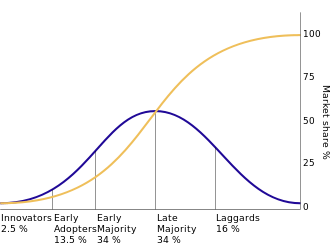The Diffusion of Innovation theory by Everett Rogers is one of the classic frameworks which helps us understand how innovation spreads. An innovation adoption curve is a decision-making tool that helps companies choose marketing strategies and tactics needed when introducing new products and services. A model that comes from the work of Everett Rogers, the curve helps enterprises evaluate consumers purchasing decisions based on how they react to technological innovations. Roger’s work shows that the diffusion process generally follows an S-shaped curve.
The Innovation Adopter Categories:
- Innovators – Those who will wait in a long line or jump onboard a new product introduction or an innovation.
- Early Adopters – An influential group of people who are taste-makers and opinion leaders.
- Early Majority – The more mainstream who will determine the mass appeal of an innovation or a product.
- Late Majority – The late nellies who wait for a couple of generations of improvements and proof points.
- Laggards – The skeptics who may be the last to be on board the bus.
Benefits of using the Diffusion of Innovation Framework:
The adoption curve provides organizations with several key benefits that can help boost sales of new products or services. The Innovation Adoption curve:
- Underlines the importance of differentiating customer segments
- Provides “first draft” that markets can use to reach customers
- Boosts profitability of new products/services
- Reduces risks of introducing new products/services
- Helps managers decide how to allocate scarce resources
Diffusions typically go through a five-stage process occurring through various communications channels over a long period among members of the same social system.
Situations/Use Cases
A wide variety of disciplines ranging from agriculture to marketing have used the Diffusion of Innovation theory to increase the adoption of innovative products, services, and ideas. Use cases include:
- Introduction of new technology-oriented products and services
- Increase the adoption of educational programs in schools
- Introduction of public health programs
- Adoption and use of social media ideas and tools
- Applying diffusion of innovation theory to social sciences, including intervention development
Getting early adopters to buy new technology products and services accelerates the potential for success.

Practical Applications of the Diffusion of Innovation Model:
Four factors influence the adoption of an innovation. They include 1) the innovation itself, 2) the communication channels used to spread information about the innovation, 3) time and 4) the nature of the society to whom it is introduced. Applications include:
- Introduction of iPhone by Apple
- Adoption of ATM cards by banks
- Introduction of Unite for Site in public health
- Adoption of new video game technology
- Introduction of autonomous driving (currently)
- Adoption of educational technology in schools
Despite drawbacks, the innovation adoption curve remains a popular decision-making tool for many companies—, especially technology firms.
Alternatives/Limitations
While the Innovation Adoption curve is useful, it’s still only a model and has limitations that can lead managers astray when promoting technology products and services.
The model tends to oversimplify a complex reality, isn’t flexible enough to fit every situation, and doesn’t provide insight into how well a product or service will do once it’s introduced.
Also, adopters may reject the new technology anytime during the adoption process. The Product Lifecycle model is an alternative to the curve. So is the Bass Diffusion model.
Tips on Applying Diffusion Theory
Markets may change, products may change, and technologies may change, but the way consumers adopt product remains constant. These five stages are:
- Product Awareness — Organizations must develop a successful mechanism for making consumers aware of new products or services. If consumers don’t know a product exists, how can they buy it?
- Product Interest — Organization need to assist in the creation of interest by providing easily accessible on the product or service. Websites, blog posts, tutorials, and videos are some ways to create interest
- Product Evaluation — Consumers need a way to examine, compare, and evaluate a product before buying it. If the item in questions is more expensive, sophisticated, or complex, this need intensifies.
- Product Trial — This is the stage where consumers “kick the tires” when evaluating new products and services. Nothing encourages the purchase of a product or service than actually trying it out.
- Product Adoption — At this stage, the consumer is ready to purchase. Organizations need to make the payment process simple, intuitive, and pain-free. Plus, they need to ensure that the consumer can easily obtain the product.
While the broad five-stage process remains the overarching model, each enterprise needs to create its own strategies and tools for taking the consumer through the process of adopting their innovations.

